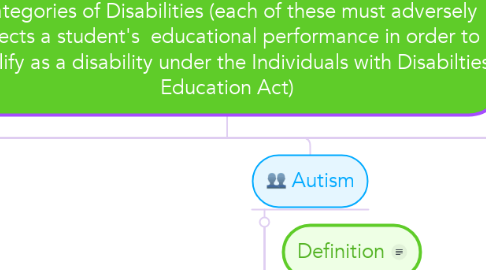
1. Developmental Delay
1.1. Definition
1.2. Modifications
1.2.1. Use multiple modalities when teaching
1.2.2. Provide frequent breaks
1.2.3. Allow children to complete activities independently
2. Deafness
2.1. Definition
2.2. Modifications
2.2.1. Priority seating in class to allow for lip reading
2.2.2. Consistent use of visual communication modes
2.2.3. Captions on films and movies in class
2.2.4. Assistance from a note-taker
2.3. Assistive Technology
2.3.1. Hearing aids or Cochlear Implants used with or without FM systems, infrared systems, or one-to-one communicators
3. Autism
3.1. Definition
3.2. Modifications
3.2.1. Class should be predictable and consistent
3.2.2. Information should be presented verbally and visually
3.2.3. Emphasize continuity between home and school by working closely with parents
3.3. Assisstive Technology
3.3.1. Picture communication board
3.3.2. Augmentative communication device
3.4. Case Studies
3.4.1. http://www.asha.org/Publications/leader/2010/100119/AutismCaseStudies.htm
4. Emotional Disturbance
4.1. Definition
4.2. Modifications
4.2.1. Use positive behavior supports in the classroom to reinforce positive and appropriate behaviors
4.2.2. Teach in small groups or one-to-one
4.3. Case Study
4.3.1. http://www.sandi.net/cms/lib/CA01001235/Centricity/Domain/155/relatedfiles/Transition%20Res%20Materials/Case%20Study%20-Emotional%20Disturbance.pdf
5. Deaf/Blindness
5.1. Definition
5.2. Modifications
5.2.1. Variety of communication systems, including: Braille, sign language, picture symbols, finger spelling, gestures, touch cues, and object symbols
5.3. Assistive Technology
5.3.1. Braille reading or writing devices
5.3.2. Amplification system or hearing aid
5.3.3. Specialized computers
6. Hearing Impairment
6.1. Definition
6.2. Modifications
6.2.1. Priority seating in class to allow for lip reading
6.2.2. Consistent use of visual communication modes
6.2.3. Caption for films and moves in class
6.2.4. Assistance from a note-taker
6.3. Assistive Technology
6.3.1. Amplification systems
6.3.2. Hearing aids
7. Intellectual Disability
7.1. Definition
7.2. Modifications
7.2.1. Teaching concepts one at a time and breaking activities into steps
7.2.2. Multiple opportunities to practice skills in various settings
7.2.3. Teach in small groups or one-to-one
7.3. Assistive Technology
7.3.1. Word processor, communication device, or special software
8. Multiple Disabilties
8.1. Definition
8.2. Modifications
8.2.1. Peer tutoring
8.3. Assistive Technoogy
8.3.1. Augmentive communication systems
8.3.2. Motor skills
8.3.3. Computer software that can spell check, grammar check, recognize speech, or read text aloud
9. Orthopedic Impairment
9.1. Definition
9.2. Modifications
9.2.1. Priority seating and wide aisles in the classroom
9.2.2. Limit how much they need to move around the room
9.2.3. Adapted physical education plan
9.3. Assistive Technology
9.3.1. Mobility aids, such as wheelchairs, scooters, and walkers
9.3.2. Augmentive Communication system
10. Other Health Impairment
10.1. Definition
10.2. Modifications
10.2.1. Access to specialized health services
10.2.2. Providing educatonal services while the child might be unable to attend school
10.3. AssistiveTechnology
10.3.1. Depends on specific conditions of a child's health problem
10.4. Case Study
10.4.1. http://aac.unl.edu/csl/andrea.html
11. Specific Learning Disability
11.1. Definition
11.2. Modifications
11.2.1. Break tasks down into smaller more management segments
11.2.2. Extended time to complete assignments
11.3. Assistive Technology
11.3.1. Computer software that can spell check, grammar check, recognize speech, or read text aloud
12. Speech or Language Impairment
12.1. Defiinition
12.2. Modifications
12.2.1. Sign language, sign cards, or communication boards
12.2.2. Offer maximum social interaction opportunities
13. Traumatic Brain Injury
13.1. Definition
13.2. Modifications
13.2.1. Give directions one step at a time
13.2.2. Use consistent routines
13.2.3. Allow for extended time to complete assignments
13.2.4. Reduce distractions and allow the student to take breaks if needed
13.3. Assistive Technology
13.3.1. Computer software that can spell check, grammar check, recognize speech, or read text aloud
14. Visual Impairment, Including Blindness
14.1. Definition
14.2. Modifications
14.2.1. Providing verbal instructions
14.2.2. Using enlarged font
14.2.3. Priority seating at the front of the classroom
14.3. Assistive Technology
14.3.1. Specialized computers or screen magnifiers
14.3.2. Braille reading and writing devices
14.3.3. Handheld audio reader or books on tape
